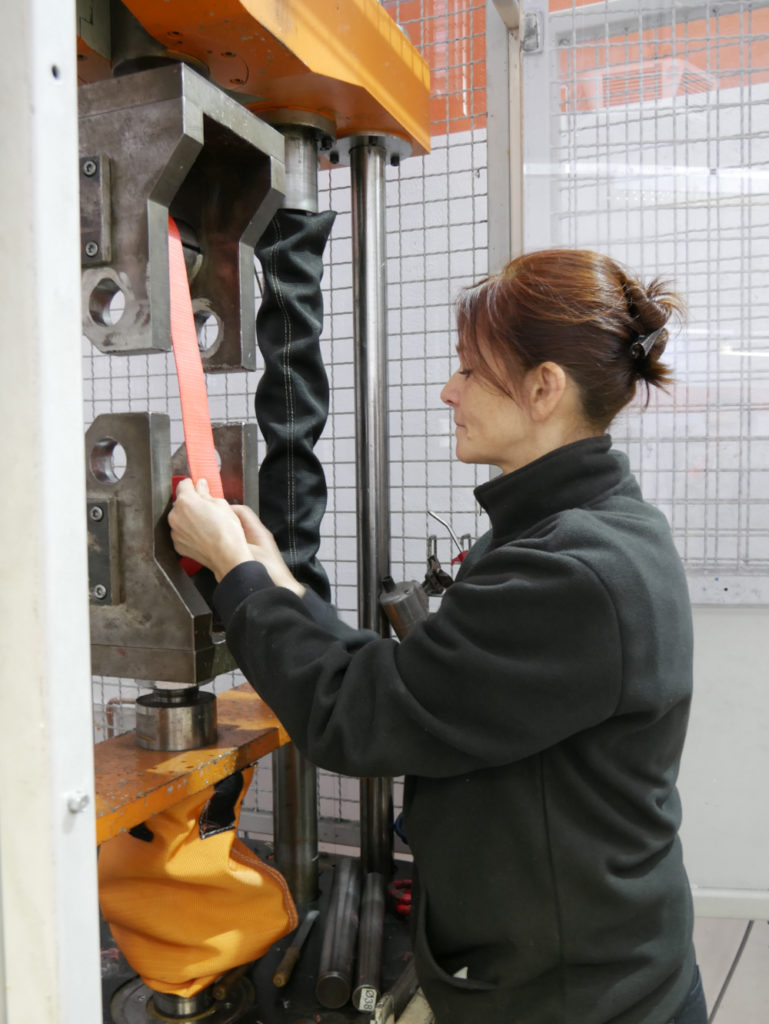A lashing strap test from A to Z
Visiting the Dolezych test laboratory
Remember? In the last issue of Dolezych Aktuell (German customer magazine, autumn 2019) we introduced Winfried Röhn. The 51-year-old engineer works in the test laboratory of our German parent company Dolezych as a member of the quality assurance team and in 2017 (almost unnoticed by his colleagues) completed a part-time mechanical engineering degree.
Now we were allowed to accompany his colleague Halina Kampa during the serial testing of a lashing strap. Her professional career is also exciting, as her path led her from being a bank clerk and physiotherapist to Dolezych in 2015 as a prospective industrial mechanic.
Extensive test preparations
Before we can start with the actual test procedures, the test conditions must be recorded in detail in special test software on the computer. The date, the product description, the name of the tester, the temperature – everything is documented in detail. Once this preparatory work is done, the “real” work can begin.
It keeps its promises – and more

“Part of a series test for a lashing strap according to EN 12195-2 are a load test, a webbing test and a tensile test. Our quality assurance system has a binding specification as to how many straps per batch size are randomly selected and tested”, Halina Kampa explains. We start with a load test in which the lashing strap inserted in the testing machine is tensioned with 1.25 times its LC (lashing capacity) and held for one minute. If the lashing belt shows no or only slight deformations or faults (as defined in the standard), the test is passed. Today’s (not surprising) result: passed with flying colors! A tensile test is then carried out to check whether the belt system, including hook and ratchet, reaches the required minimum breaking force. Here too, our tested lashing strap delivers what its label promises. Between the individual tests Halina Kampa runs to the computer again and again to enter the test parameters and the subsequent results. The last thing she has to do is successfully complete the webbing test, which consists of a tensile test (here the webbing is loaded with 3 times the LC of the lashing strap) and an elongation test (according to the standard max. 7%, Dolezych guarantees even max. 5%). The lashing strap tested by Halina Kampa also passes both tests without any problems.
Safety beyond the norm
All in all,
our visit – and therefore the testing process for just one lashing strap –
takes about half an hour (usually a random sample of three lashing straps is
even tested). Contrary to what one would expect, however, the inspection
process itself takes up the least amount of time. “The test pre- and
-postprocessing is what is very time-consuming, because all the values and
settings have to be precisely documented,” explains Halina Kampa.
“But however complex the whole thing may be – in the final analysis, it is
not just a question of acting in accordance with the standard as a
manufacturer, but of supplying our customers with high-quality and safe
products. This is worth the effort”.
For those who want to know exactly
The series inspection of a random sample of three lashing belts takes about 1 ½ hour, and an overall inspection (e.g. for initial samples) even takes a whole day. Binding test components are specified in the standard DIN EN 12195-2:
- Series testing: load test, webbing test, tensile test
- Overall test: load test, webbing test, tensile test, hand lever test, cycle & pretension test
